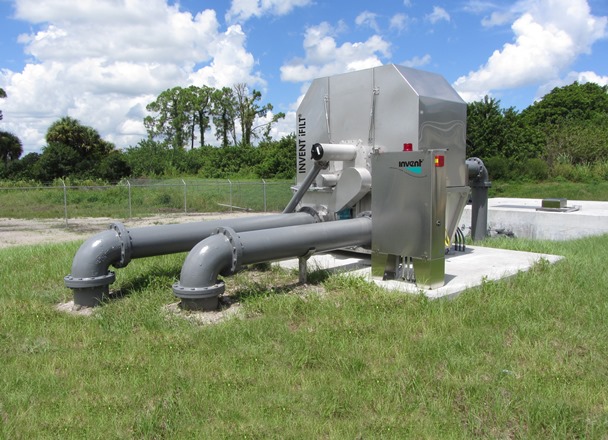INVENT Press Release
For awhile, the term microplastics has been one the public has become familiar with and has focused on more frequently. Even though the breadth of the problem may be hard to grasp, studies have shown that microplastics represents a danger to humankind and the environment. State-of-the-art wastewater treatment plants equipped with the relevant filter technology are already able to filter out microplastics from the wastewater, thereby drastically reducing the release into the environment. The research project “Removal of Microplastics from the Water Cycle (OEMP)” conducted by the German Federal Ministry of Education and Research employed the iFILT®-Diamond Filter for two years in an effort to retain microplastics – and the results were impressive.
Based on the current definition, microplastic particles are smaller than 5 mm. They are broken down into two groups: primary microplastics, as a component found in numerous products such as cosmetics and care products as well as in cleaning products, and secondary microplastics, produced by physical, biological and chemical degradation processes from large plastic parts, e.g. granulated plastic bottles. Microplastics can be released into the environment either directly or indirectly. They can be released through water bodies and by land (wind, rain). Just like paper, fibers and particles from clothing and cosmetics, microplastics are flushed into all types of water through household drains, sewers and wastewater treatment plants. Our knowledge about the amounts released into the environment and the potential retention is as of yet still limited. The German Federal Ministry of Education and Research dedicated the research project “Removal of Microplastics from the Water Cycle (OEMP)” to precisely these questions.
As part of this research, the iFILT®-Diamond Filter was tested in the removal of microplastics in the area of wastewater treatment plant discharge and mixed water overflow. The novel Diamond Filter is based on a revolutionary fluid mechanics general concept. The basic idea is to combine an optimized fluid mechanics design with the cross-flow filtration process engineering approach. This allows a high hydraulic performance to be achieved despite minimum space requirements, yet with an optimum of separation efficiency. The continuous rotation of the filter wheels, the effect of tangential-dynamic filtration that it initiates and the sharp separation limit of the stainless steel high performance weave mesh utilized provide for guaranteed high separation efficiency.
During the course of the research project, GKD-Gebr. Kufferath developed a novel stainless steel high performance weave mesh, which was then tested using the iFILT®-Diamond Filter. The weave mesh that was developed feature extremely small opening widths of 6 and 8 µm. They are the absolute pore size that guarantee that no spherical particles any larger than the opening widths can make their way through the discharge of the filter. The filter media primarily used up until now have featured an absolute separation limit in the range of 15 μm. The slot-like pore geometry of the weave mesh ensures excellent retention of particles. The openings in the mesh are larger than on the mesh surface, ensuring good regenerability.
The tests of the wastewater treatment plant discharge were carried out at the wwtp Berlin-Ruhleben, Germany, with wastewater equivalent to up to 1.6 million inhabitants. The daily treatment performance was 247,500 m3, which increased to up to 600,000 m3 wastewater during rainy weather. The biological treatment method included an activated sludge process with denitrification and biological phosphorus elimination. In order to create valid comparison values, the Diamond Filter was first equipped with a standard 20 μm weave mesh. This step already reduced the dirt load of filterable substances (AFS) from 5 mg/l in the inflow to below 3 mg/l in the discharge.
After retrofitting to the new weave mesh with a separation limit of 6 μm, the discharge concentration was then further reduced from 3 to 2 mg/l. In addition to increasing the separation performance, due to the novel weave mesh and the revolutionary Diamond Filter concept, yet an even higher throughput capacity was achieved. With a filter wheel, throughput rates of 110m³/h could still be achieved when using the 6 μm mesh. In relation to the installed filter area, this equates to a specific hydraulic capacity of 22 m³/(m²xh), which is an absolute peak value in the field of gravity filtration.
The measurements for microplastics showed that the total plastic masses were subject to considerable fluctuations even within one day. It was not possible to determine any system in the values. While traces of plastic were found in the wastewater treatment plant discharge, they were hardly detectable in the discharge of the Diamond Filter. The tests confirmed that significant traces of plastic even in the lower μm range were removed from the water.
For the mixed water treatment tests, the Diamond Filter was set up in the mixed water overflow basin. The concentrations of filterable substances are significantly higher here as compared to the wastewater treatment plant discharge. Even for mixed water, the iFILT®-Diamond Filter with the 6 μm weave mesh was able to achieve a separation performance of filterable substances in excess of 99%.
These results are extremely promising! The iFILT®-Diamond Filter has been demonstrated to reduce the environmental pollution related to the release of microplastics into water. By expanding the wastewater treatment plants with the tertiary Diamond Filter and thereby almost completely removing microplastics, adverse consequences to the environment and humankind can be reduced.




